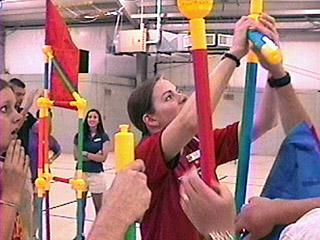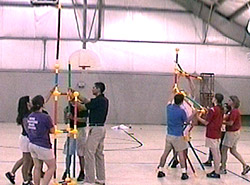Activity 22: Tallest Tower



Tallest Tower Activity
Activity Plan
Group Size: 2 - 5
Time: 10 - 25 minutes
Mental Intensity: 2
Physical Intensity: 1
Space: Medium
Objectives
- Brainstorm and share problem-solving strategies to build the tallest tower
- Work as a team to build the tallest tower possible
- Discuss their experience and feelings
Character Focus
Cooperation
Preparation
Time: 1 minute
Materials:
1 Toobeez set
1 envelope
chart paper (optional)
Setup:
- Place the Risk Taking Note into an envelope.
- Divide the contents of the Toobeez set for two teams. If you have only one team, you may provide them with an entire set of Toobeez, but please read the safety reminders regaring this choice.
The Challenge
Working as a team, build the tallest tower that you can.
Note: Jim Cain, author of “Teamwork & Teamplay,” first introduced this activity to the author.
Safety Reminders!
Appropriate caution is important to conduct these activities in a safe manner. Be sure to review these reminders prior to beginning the activity, and if necessary, share reminders with the group during the activity.
- Follow general safety procedures
- Towers may fall over. Be careful not to get hit by a falling tower
- You can supply a team with an entire set of Toobeez (52 pieces), but watch out – the tower they build will be very tall and potentially very dangerous if it falls over
Helpful hints
- Keep the size of each team small (two-five people). When the teams are larger, people end up standing around watching rather than participating
- You’ll note that one guideline states that everyone must keep at least one foot on the ground. This is to prevent people from sitting (even standing) on teammates’ shoulders as they build a tall tower. It also prevents people from standing on chairs, tables, ladders, etc. What people will learn to do is build the tower horizontally and then push it to vertical
Activity Instructions
- Circle up the group. Distribute or display the appropriate “Risk Taking Note” for the activity. Have one participant read it aloud twice. Provide a few moments for the participants to think about the message:
“Life shrinks or expands in proportion to one’s courage” - Anais Nin - Share the following storyline with group.
This tower will help you to reach the moon! Use your imagination and see how high you can go. - Read aloud the following Activity Challenge Box to the group.
Challenge: Working as a team, build the tallest tower that you can. Follow the guidelines below:- Each tower must be free-standing and must be able to support itself for 30 seconds
- The height of the tower will be measured from the floor
- Only Toobeez can be used to build the tower
- All team members must keep at least one foot on the floor
- Team members may not interfere with another team’s tower
- If any guidelines are broken, the group must begin again
- Before the participants attempt an activity challenge, have the group work through the following six steps:
- Circle up
- Know and understand the challenge and the guidelines
- Brainstorm
- Make a plan
- Do the plan
- Evaluate results and adjust as necessary
- If you set up this activity to be competitive (i.e. two or more teams building towers), you will have opportunities to discuss how the team members handled the notion of competition. Some people will do anything and say anything just to win – even at the expense of the relationships with their own teammates. If you see this type of behavior, address it. Ask them if their behavior creates a culture of sustainability and excellence (you may first have to define excellence and sustainability with the group).
- If a touch occurs, choose one of the following penalties: A) everyone starts again, B) only one person has to travel back through, C) the group may not communicate verbally for five minutes, or D) a combination of these.
- If participants get stuck, have the students circle up again. Here are some suggested questions to help guide the group back on track*:
- What is working?
- What ideas have you not tried yet that someone suggested?
- If your group is still struggling OR if you feel your group would benefit from an additional challenge, present a variation provided on the next page.
- After the activity, move to the debriefing questions for discussion.

Problem Solving Sequence:
Activity Variations
- Cooperative play without competition.
Consider creating a situation where the small teams work together. For example, challenge the teams to build the tallest tower they can. When the towers are complete, measure each tower and add the measurements of each tower together to create a TOTAL TOWER MEASUREMENT. Then, ask the groups to disassemble their towers and build new towers using the best practices they discovered from all the teams. The goal is to build towers that are taller than before, beating the TOTAL TOWER height of the first round. This way, all teams contribute to a win.
Debriefing the Activity
Use these debriefing questions as a guide for your discussion. Select the questions you feel will best benefit your group. It is not mandatory to cover every question. If possible, record the group’s responses on flip chart paper so all comments are displayed. Make sure to let everyone share their ideas, and remind participants that everyone’s opinions and feelings are important!
Base questions for debriefing:
- What did you just do together?
- How did you feel while you did the activity?
- What was one positive thing that happened during this activity?
- What was one of the challenges of doing this activity?
- What did the group have to do or believe to be successful?
If the group was unable to complete the task in the given time:
- Since you were not able to solve the problem, does it mean your group is a failure? (Push the group to respond with more than a “yes” or “no” and to instead point out and discuss what they learned.)
- If the tower fell, ask how it felt when the tower fell?
Additional questions: Choose which ones are the most appropriate:
- How can our group do more with less?
- How do you feel now?
- What advice would you give to another group working on this activity?
- Did you try different ideas? If so, why did you change your approach?
Close on a Positive Note
Sum up the different ideas and feelings that you heard expressed, and restate ideas and learning moments the participants shared. Then, read the Risk Taking Note out loud again, and ask people to discuss what they think this note means. Discuss what they thought it meant at the beginning and what they think it means now.
* (ˆ) Do not provide the participants with answers. Allow them to work together.





